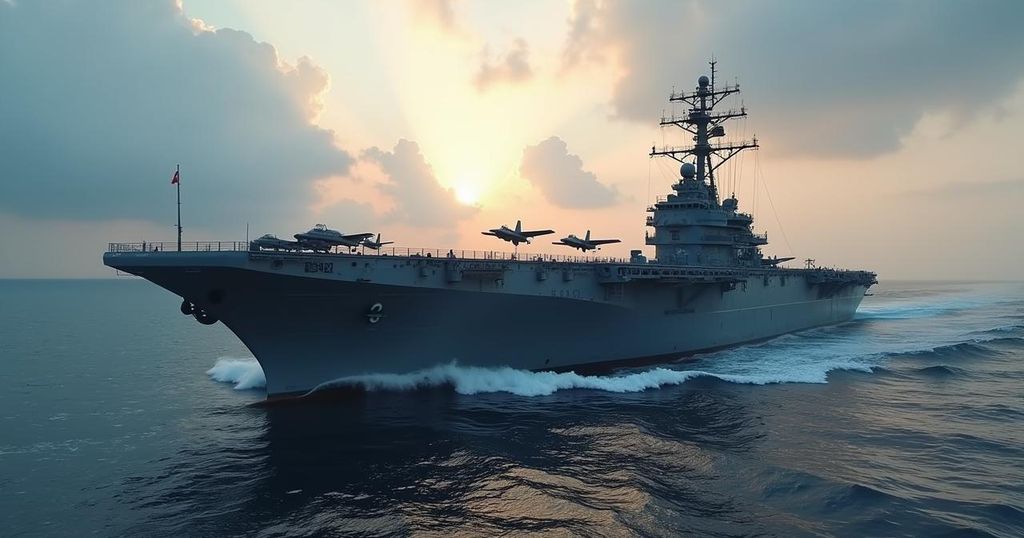Chinese Aircraft Carrier Activities Near the Philippines and U.S. Marine Deployment
The Chinese Liaoning Carrier Strike Group is operating southeast of Mindanao, Philippines, while the U.S. Marine Corps has deployed forces for six months of training exercises in the region. This reflects ongoing military activities between the nations to enhance cooperation and security.
The latest reports from Japan’s Joint Staff Office indicate that the Chinese Liaoning Carrier Strike Group (CSG) is actively operating southeast of the Philippine island of Mindanao and progressing toward the Celebes Sea. This comes as the United States Marine Corps has announced the arrival of the Marine Rotational Force – Southeast Asia (MRF-SEA) in the Philippines for a deployment lasting six months. The Joint Staff Office’s release confirmed the presence of numerous People’s Liberation Army Navy (PLAN) vessels, including the aircraft carrier CNS Liaoning, in the Philippine Sea since September 20. A detailed account was provided about the Liaoning CSG’s composition and activities from September 20 to 26, with new information released on Wednesday about the CSG’s operational movements and activities recorded from Friday to Tuesday. During this timeframe, the Liaoning executed 130 aircraft operations, including both take-offs and recoveries of fighter jets, and 90 helicopter movements, bringing the total to 220 sorties conducted within those five days and cumulatively 630 sorties since September 20. From Tuesday to Wednesday, the Liaoning CSG along with additional PLAN vessels maneuvered southwest in the waters east of the Philippines. A map provided in the release showed their last known location to be southeast of Mindanao, gradually approaching the Celebes Sea, monitored closely by destroyers JS Asahi and JS Kirisame. The report detailed the Liaoning CSG’s positions relative to Okinotorishima, a Japanese-administered atoll situated midway between Taiwan and Guam, throughout several dates in late September and early October. Concurrently, on Wednesday, the U.S. Marine Corps outlined that U.S. Marines and sailors, part of I Marine Expeditionary Force (MEF), commenced their third annual rotational deployment in the Philippines. This deployment is aimed at strengthening military relationships through participation in joint exercises, namely Sama Sama 2024 and Kamandag 8, set to occur from October 7 to 24. The MRF-SEA deployment will extend through March 2025, featuring six further military exercises and numerous security cooperation engagements throughout Southeast Asia. The exercises are organized in coordination with various military forces, including the Philippine Marine Corps and other regional armies. Colonel Stuart W. Glenn, commanding officer of MRF-SEA, expressed the goals of this deployment by stating, “The Marine Corps is committed to preserving the freedom of the region and its people. We train together to strengthen our relationships and collective capabilities, and the intent of MRF-SEA is to cultivate and reinforce the common values and capabilities between our partners and to preserve a rules-based international order.”
The recent military maneuvers of the Chinese Liaoning Carrier Strike Group in proximity to the Philippines reflect ongoing regional tensions in East Asia, influenced by rising military capabilities of China. In parallel, the U.S. strategically deploys forces in the region to bolster alliances and enhance collective defense capabilities among regional partners. Such actions are framed within a broader discourse about maintaining freedom of navigation and regional stability in the Indo-Pacific.
The operational activities of the Chinese Liaoning Carrier Strike Group near the Philippines, alongside the deployment of U.S. Marine forces, underscore the intensifying military presence in the Indo-Pacific region. Both these moves signify a profound commitment to enhance collective defense capabilities and uphold a rules-based international order amidst regional challenges.
Original Source: news.usni.org








Post Comment